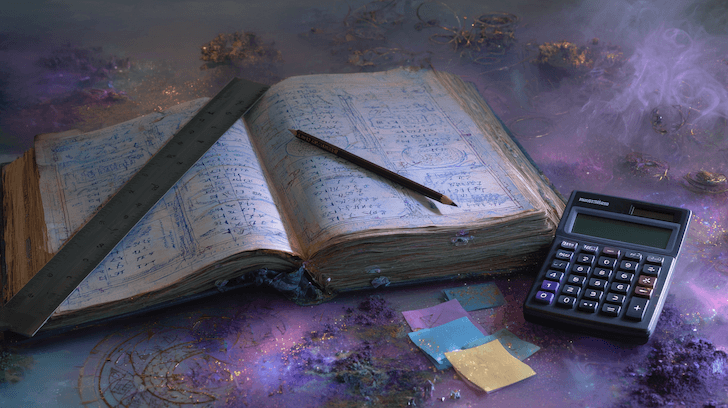How to Read an Ephemeris

An ephemeris is the astrologer’s calendar — a day-by-day record of where every planet, luminary, and key point sits in the zodiac. Before astrology software, it was the only way to cast charts, track transits, and follow celestial motion by hand.
An ephemeris shows the zodiacal position of each planet (in degrees and minutes) for every date. Learning to read it gives you direct awareness of how planets actually move through the sky.
Why Use an Ephemeris
Even with modern tools, an ephemeris remains essential. It shows planetary movement at a glance — something no chart wheel alone can do.
- Track when planets form transits to your natal chart.
- Watch retrograde cycles start, peak, and end.
- Spot ingresses when planets change signs or houses.
- Follow New Moons, Full Moons, and eclipses.
- Study historical planetary cycles over decades or centuries.
- Plan electional charts (timing for key actions).
How an Ephemeris Is Structured
Every ephemeris, whether printed or digital, follows the same idea: each row represents a date, and each column lists the position of a planet or point.
| Component | Meaning |
|---|---|
| Date | The calendar day of the entry (e.g., Apr 15, 2025) |
| Sun, Moon, Mercury–Pluto | Each planet’s exact degree and minute within its sign |
| R (Retrograde) | Indicates the planet is in apparent backward motion |
| Ingress | The date a planet enters a new sign |
| Aspects | Markings that show when planets align exactly (conjunction, trine, opposition, etc.) |
| Lunar Phases | Entries for New, Quarter, and Full Moons |
Each planet’s position looks something like: Venus 22° Pisces — meaning Venus is at 22 degrees of Pisces on that day.
Degrees, Signs, and Motion
The zodiac covers 360° total, divided into 12 signs of 30° each.
An ephemeris lists these positions as degrees (°) and minutes (').
When a planet moves from 29°59' Pisces to 0°00' Aries, it’s called an ingress — a tone shift that can be felt both globally and personally.
Retrograde planets are marked with an R (e.g., Mercury 8° Taurus R). When the R disappears, the planet has turned direct again. A few days around the change are the station periods — slow, potent moments that often mark reversals or realizations.
Daily vs. Monthly Ephemerides
There are two common formats:
- Daily Ephemerides: Show every planet’s position for each day — ideal for timing Moon phases and fast-moving transits.
- Monthly Ephemerides: Show positions on the first of each month — perfect for studying long-term patterns and outer planets.
The Moon moves roughly 13° per day, changing signs every 2–3 days, so a daily ephemeris is especially useful for tracking emotional tone.
Example: Reading a Single Day
Here’s how an entry might look in your ephemeris:
| Planet | Position | Notes |
|---|---|---|
| Sun | 25° Aries | Aries season—self-directed, bold energy |
| Moon | 12° Gemini | Mental, communicative mood |
| Mercury | 8° Taurus R | Retrograde—communication delays, reflection |
| Venus | 22° Pisces | Romantic, compassionate tone |
| Mars | 17° Cancer | Emotion-driven action, protective |
| Jupiter | 2° Gemini | Curiosity and intellectual growth |
| Saturn | 15° Pisces | Discipline through compassion |
| Uranus | 20° Taurus | Steady innovation, tension between comfort and change |
| Neptune | 28° Pisces | Dreamy, intuitive atmosphere |
| Pluto | 2° Aquarius | Societal change, experimentation with power |
By reading this single entry, you can intuit the day’s energetic weather—where momentum, reflection, and sensitivity lie.
Practical Uses for Your Own Chart
Once you understand how to read positions, the next step is to compare them to your natal chart.
- Check which planets are transiting your natal houses for active life themes.
- Note aspects between transiting and natal planets (trines, squares, conjunctions).
- Watch for retrogrades revisiting key points—it’s common for stories to unfold in three acts.
- Time New and Full Moons to see where they land in your chart for new beginnings or release.
- Follow outer planets (Saturn, Uranus, Neptune, Pluto) for slow-burn transformation.
You don’t need math—just pattern recognition. With practice, reading an ephemeris becomes second nature and helps you sync to planetary rhythm.
Tips for Beginners
- Start by following the Sun, Moon, and Mercury daily to build awareness.
- Use color coding or notes to mark retrogrades and ingresses.
- Watch how outer planet shifts correspond to real-world changes.
- Keep a short journal—record key dates and what you felt or noticed.
- Compare today’s sky to your birth chart weekly—patterns will start to emerge naturally.
Conclusion
An ephemeris is the bridge between astronomy and astrology— a living record of cosmic motion that connects the heavens to daily life. By learning to read it, you move from passive horoscope reading to active celestial observation.
How to Read Transits

Planetary Returns in Astrology

Get Your Birth Chart
Calculate your complete astrological chart with precise astronomical data based on your birth time and location
Generate Chart